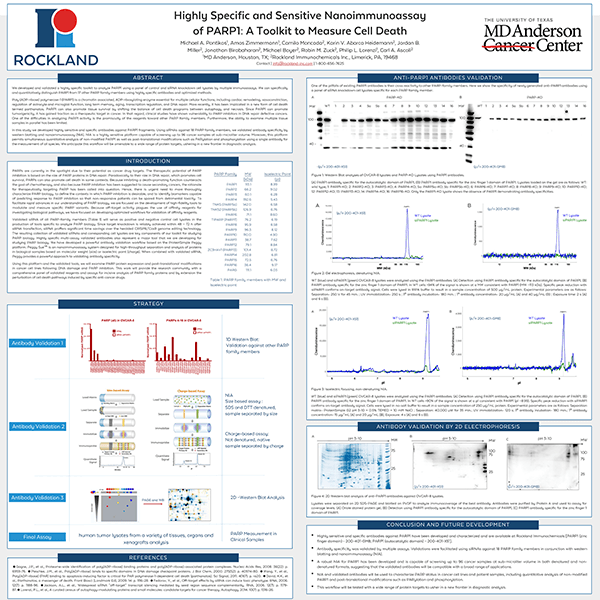Highly Specific and Sensitive Nanoimmunoassay of PARP1: A Toolkit to Measure Cell Death
We developed and validated a highly specific toolkit to analyze PARP1 using a panel of control and siRNA knockdown cell lysates by multiple immunoassays. We can specifically and quantitatively distinguish PARP1 from 17 other PARP family members using highly specific antibodies and optimized methods.
Poly (ADP-ribose) polymerase-1 (PARP1) is a chromatin-associated, ADP-ribosylating enzyme essential for multiple cellular functions, including cardiac remodeling, vasoconstriction, regulation of astrocyte and microglial function, long-term memory, aging, transcription regulation, and DNA repair. More recently, it has been implicated in a new form of cell death termed parthanatos. PARP1 can also promote tissue survival by shifting the balance of cell death programs between autophagy and necrosis. Since PARP1 can promote tumorigenicity, it has gained traction as a therapeutic target in cancer. In that regard, clinical studies have shown vulnerability to PARP inhibitors in DNA repair defective cancers. One of the difficulties in analyzing PARP1 activity is the promiscuity of the reagents toward other PARP family members. Furthermore, the ability to examine multiple tissue samples in parallel has been limited.
In this study we developed highly sensitive and specific antibodies against PARP1 fragments. Using siRNAs against 18 PARP family members, we validated antibody specificity by western blotting and nanoimmunoassay (NIA). NIA is a highly sensitive platform capable of screening up to 96 cancer samples at sub-microliter volume. Moreover, this platform permits simultaneous quantitative analysis of non-modified PARP1 as well as post-translational modifications such as PARylation and phosphorylation using a single antibody for the measurement of all species. We anticipate this workflow will be amenable to a wide range of protein targets, ushering in a new frontier in diagnostic analysis.
